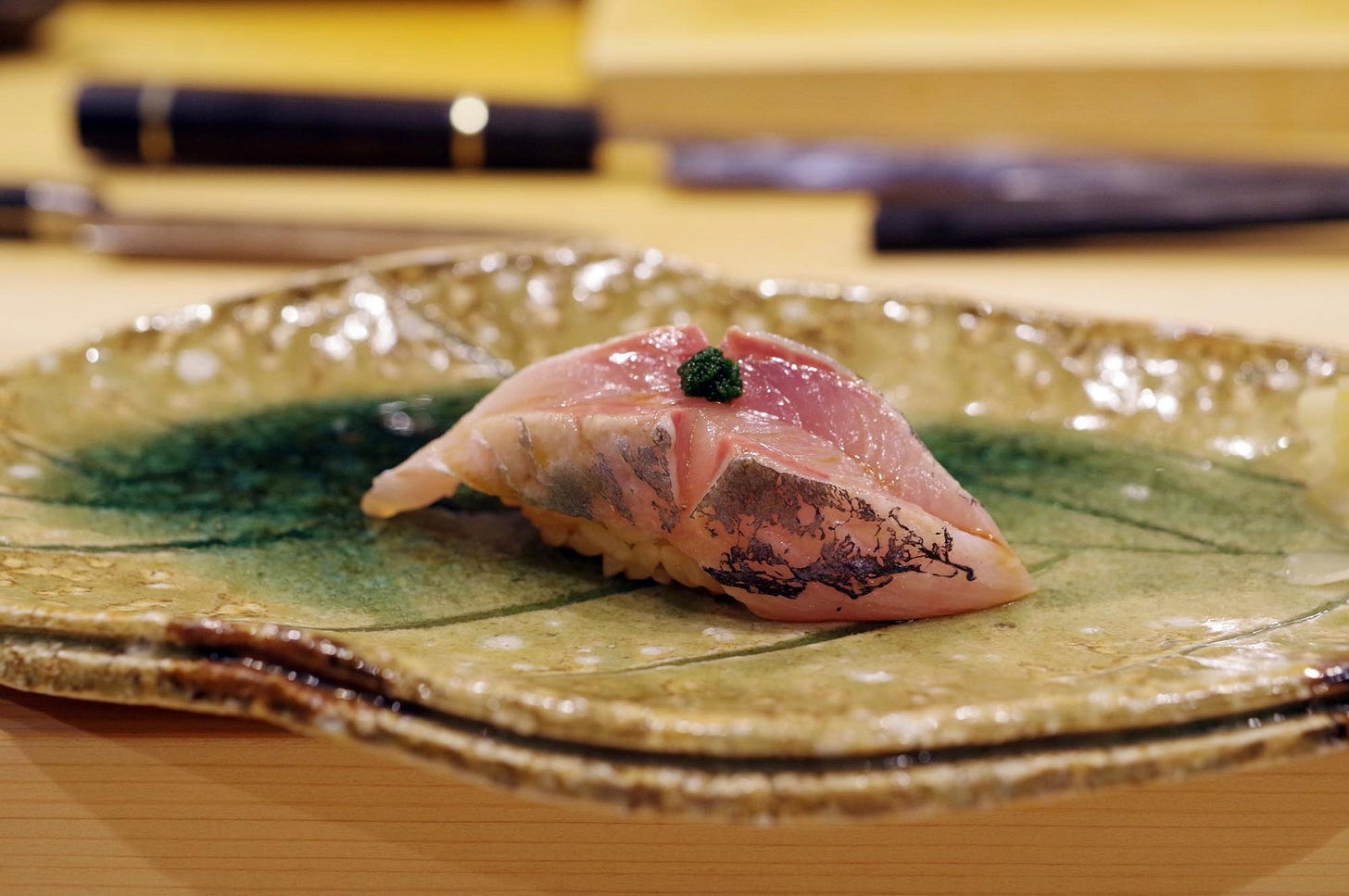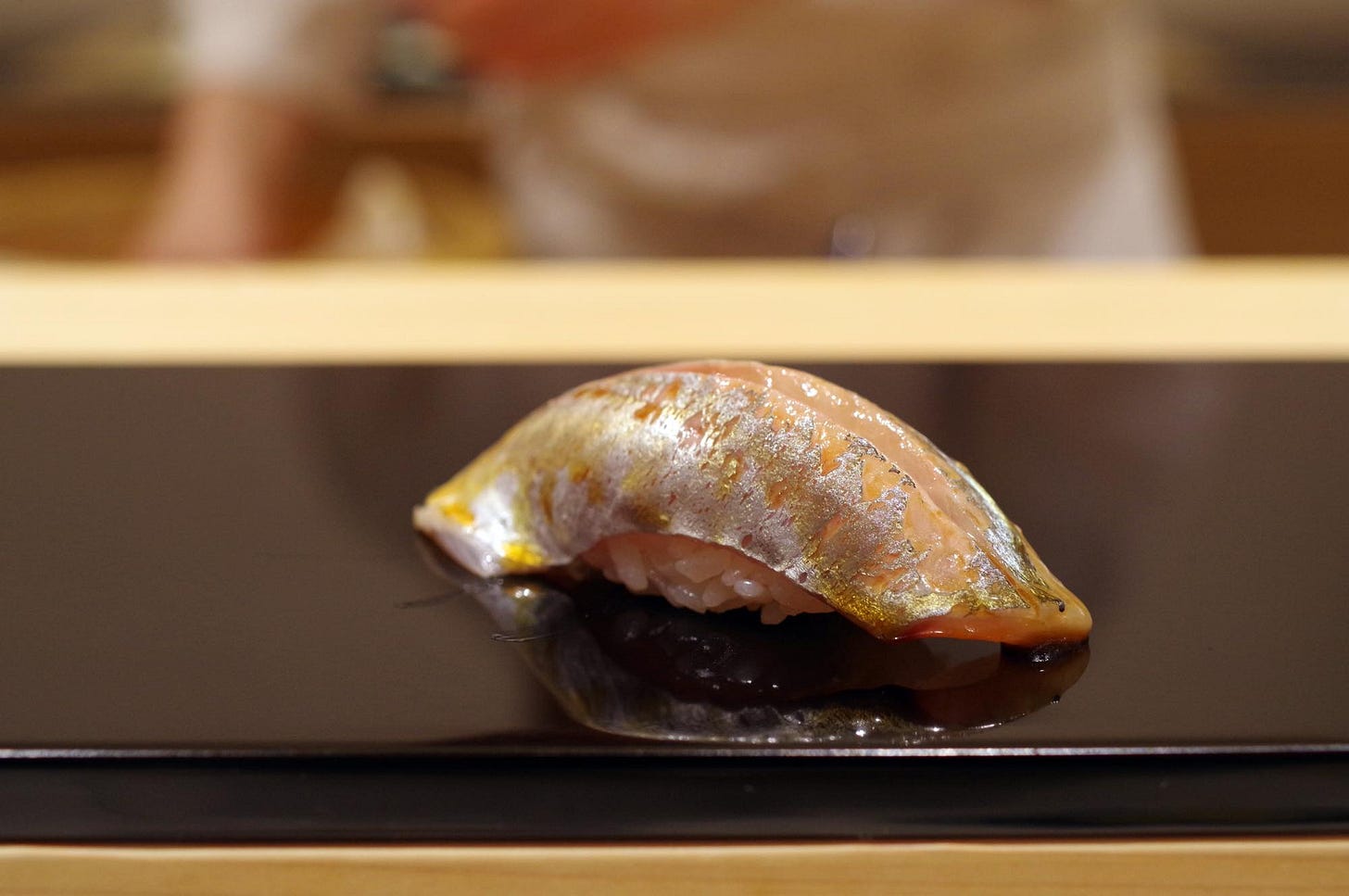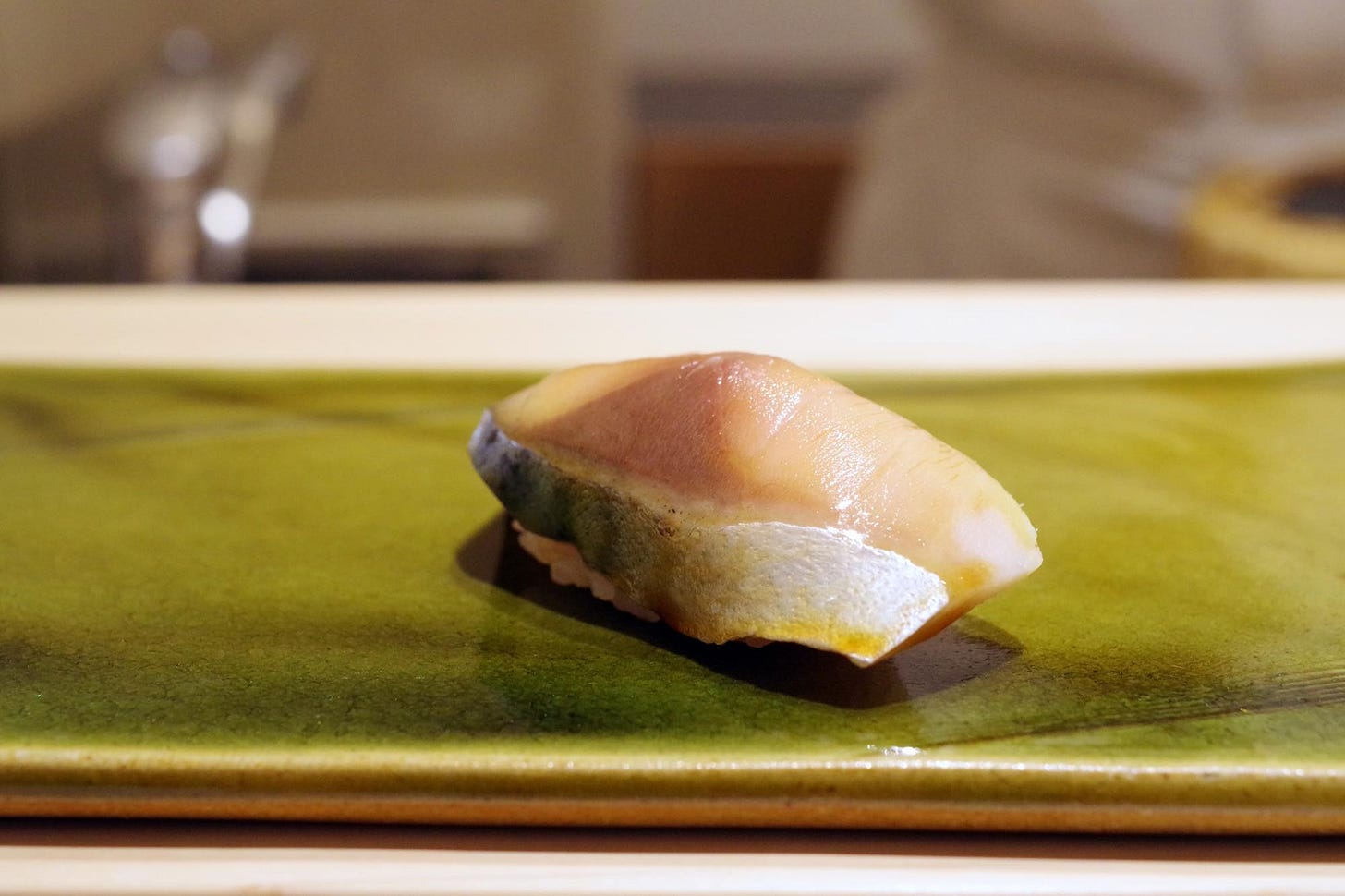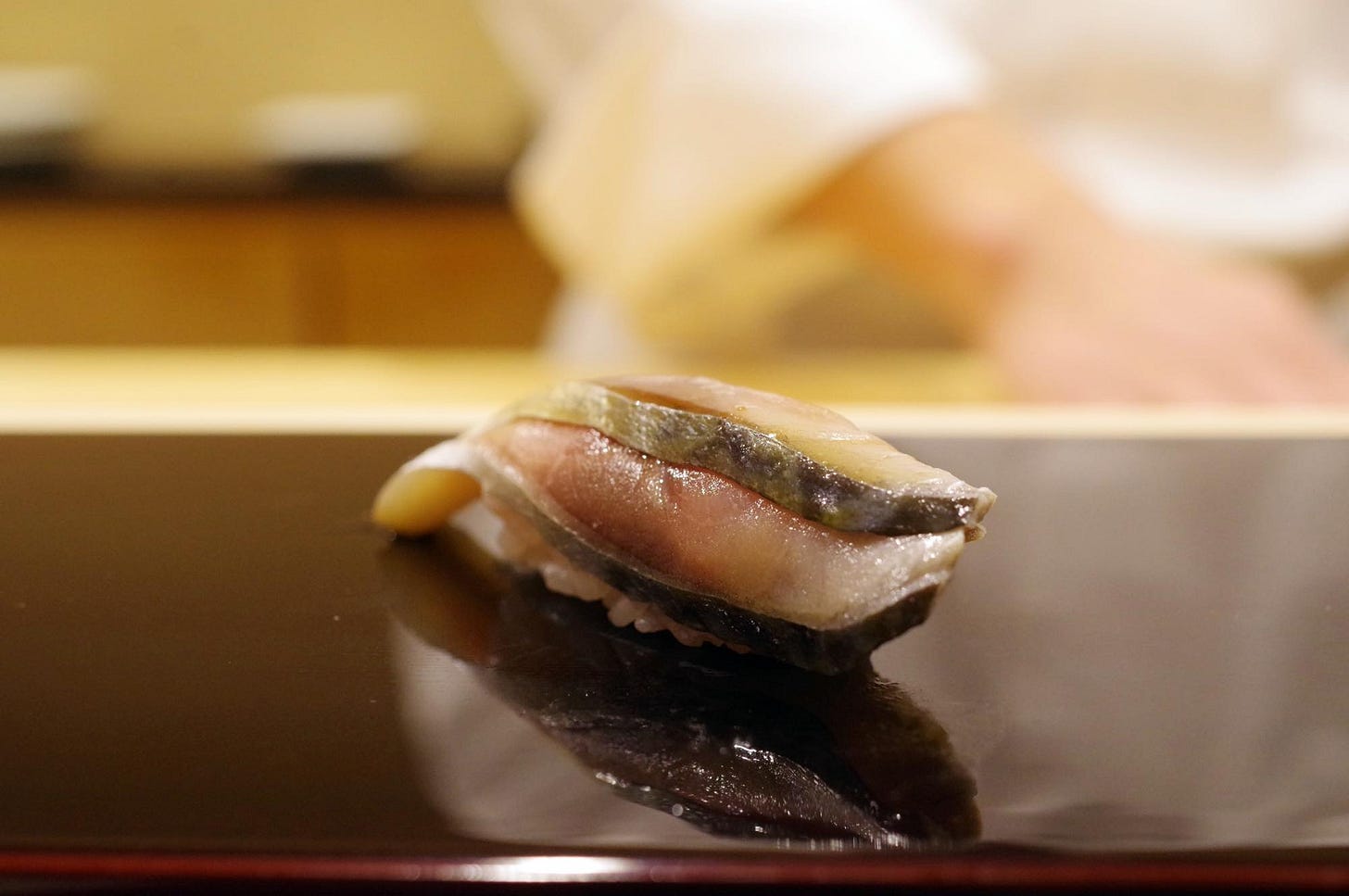For the 10th installment of "Traditional Sushi Varieties," I would like to introduce horse mackerel and mackerel. These are the two top hikarimono (silver-skinned fish) that Japanese people love. They pair well with the Edomae-zushi method of preparing the fish and are delicious with sushi rice.
Horse mackerel (Aji)
Mackerel (Saba)
Horse Mackerel (Aji)
Japanese Name: Aji
English Name: Horse Mackerel
Sushi Topping Category: Silver skinned fish
Main Seasonal: Summer
Horse mackerel is a bluefish that becomes fatty in late spring, early summer, and summer. Even in late April to early May, when it is at the peak of its season, the best horse mackerels are very tasty. Although horse mackerel is famous as a popular fish, the horse mackerel used in sushi restaurants is a high-end fish. Selected horse mackerels from all over Japan dance on the counters of sushi restaurants. Arai Hakuseki, a renowned scholar of the Edo period (1603-1867), once said, "Horse mackerel is good because it tastes good." In Japanese, “Aji“ stands for both horse mackerel and taste. It sounds like a joke, but it is true. In 1717, he wrote in his dictionary "Tōga" that "horse mackerel is a taste, and the beauty of its taste is called 'aji'." Even today, horse mackerel is loved by people all over Japan. Since horse mackerels are caught all over Japan, some places boast of their horse mackerels and try to brand them with a special name. Although horse mackerels are migratory fish, there are places that brand horse mackerels that do not migrate but stay in one place, such as "netsuki" or "setsuki."
The most famous production area for sushi-grade horse mackerel is Izumi in Kagoshima Prefecture. The price of horse mackerel from Izumi is the highest at Toyosu Market. The horse mackerels here have a great amount of fat, but they are also muscular, so they are not heavy, and the fat is sharp. In other words, it has both fat and texture, which goes well with the sour rice.
Also gaining recognition with a unique name is the "dongchichi horse mackerel" from Hamada, Shimane Prefecture. This horse mackerel is extremely fatty. Whereas the fat content of ordinary horse mackerels is 3.5%, the fat content of dongchichi horse mackerels is 10% to 15%. It is a very tasty horse mackerel, but the author feels that if the chef does not work with it properly, it will lose its balance with the rice. The number of sushi chefs who use it is rapidly increasing, but using it and mastering it are two different things.
The author also finds the horse mackerels from Sagami Bay, especially those from the Odawara area, to be very tasty, both in terms of fat and aroma. The horse mackerels from Kanaya (Futtsu City) in Chiba Prefecture also have an impressive flavor. Although a popular fish, horse mackerel changes its flavor depending on its location. It is an interesting fish that should not be underestimated.
When savoring aji (horse mackerel) at a sushi restaurant, pay attention to these key aspects:
Aroma
Fat
Texture
Use of condiments
Horse mackerel is a fish whose aroma precedes its taste. It is not important if the fish has a bad smell, but it is important if it has a fresh aroma that reminds one of the sea, which is unique to horse mackerel. The area of the sea and the size of the fish are also important, but there is no doubt that the taste is also greatly affected by the method of treatment and transportation after the fish has been caught. The most notable aspect of a delicious horse mackerel at a sushi restaurant is its outstanding aroma. After the aroma, the fat that is characteristic of the horse mackerel in season seeps out, and combined with the acidity of the rice, it transforms into a dense, emulsified flavor. However, because it is different from tuna toro or nodoguro (blackthroat seaperch), the fat fades away with the aroma without leaving any residue. It is truly refreshing. The texture must have the right amount of chewiness. Even if the fish is left to rest, if it does not have a firm texture, it loses its horse mackerel-like quality.
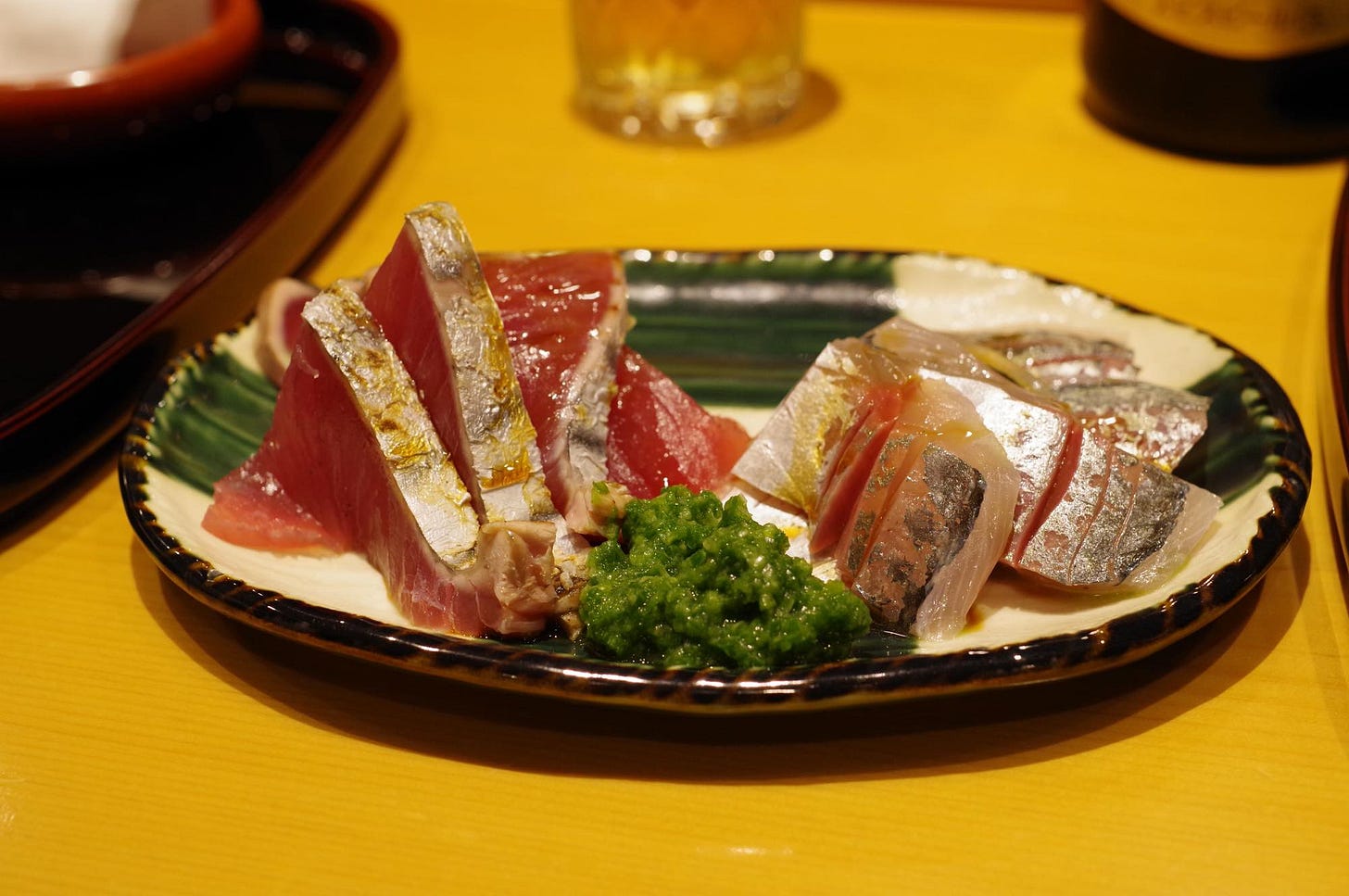
The most important thing is the use of condiments. Green onions and ginger are often used because they pair well together. "Atari-negi," a combination of pounded green onions and ginger, is an extremely popular condiment. Strangely enough, its aroma is reminiscent of garlic, which is probably to the liking of modern people. This combination condiment was developed by Okada Oyakata of Shimokitazawa's Kozasa Sushi. Many sushi chefs are unaware of it, so please enjoy this interesting piece of sushi trivia. Now, as for condiments, it is not just a matter of using them. It is important to control the amount, in other words, the aroma. It would be tactless to use more yakumi (condiments) than the fresh aroma unique to horse mackerel, which I mentioned earlier. The work in which the aroma of green onion or ginger precedes the aroma of horse mackerel may be fine in a popular restaurant, but it is not acceptable in a high-class restaurant.
Mackerel (Saba)
Japanese Name: Saba
English Name: Mackerel
Sushi Topping Category: Silver skinned fish
Main Seasonal: Autumn - Winter
October to November is considered "Autumn Mackerel," and December to February is considered "Cold Mackerel."
Along with kohada (gizzard shad), mackerel is one of the most representative bluefish in sushi. It plays a leading role not only in Edomae-zushi but also in other types of sushi throughout Japan, such as saba-bo-zushi in Kyoto, battera in Osaka, and kakinoha-zushi in Nara and Wakayama. At home, mackerel is usually grilled with salt or simmered in miso, but in sushi, salt and vinegar curing are almost mandatory. This is because the fish becomes much more compatible with the rice when it is vinegared. In Oita and Kagoshima, raw mackerel is sometimes served, but while the freshness that can only be experienced in these areas is a delight, I feel that vinegared mackerel is better for the sense of unity as a sushi dish. The fat of the mackerel comes to life when it is cured, and the flavor spreads in waves as you bite into it. There are many Japanese who are not fond of vinegared mackerel, and I used to be one of them. The reason for this is obvious: the mackerel served at izakaya (Japanese-style pubs) or kaitenzushi (conveyor-belt sushi) restaurants. When low-quality mackerel, which is normally not suitable for raw consumption, is overcooked with salt and low-quality grain vinegar, it is natural that the negative aspects of the mackerel are brought into sharp relief. And since the mackerel will not be used up by the end of the day, the negatives will be amplified. What I am trying to say is that those who are not fond of vinegared mackerel should try seasonal vinegared mackerel nigiri at a high-quality Edomae-zushi restaurant. You will find out that it is a completely different thing, and your life will be richer for it.
When savoring saba (mackerel) at a sushi restaurant, pay attention to these key aspects:
Aroma
Texture
Fat content
It is very important for mackerel to have "no negative odor and an appetizing aroma," which is an essential prerequisite. The points to examine the degree of curing are texture, fat, umami, saltiness (salty), vinegar (sour), and balance with the rice. For example, if the mackerel is too acidic for the rice, the good parts of the mackerel will be blurred. Also, if the fish is too watery, it is a complete failure. Older sushi chefs avoid this type of finishing. A skilled sushi chef can make a mackerel that is fresh and ecstatic when it is emulsified with rice, even though it is tightly cured.
The fat content is the mark of quality for mackerel. More fat is not necessarily better, and if the fat content is not optimal, the curing work should bring out the attractiveness of the mackerel. If you judge the quality of mackerel only by the amount of fat, you will lose sight of the true nature of the fish. The true way to enjoy hikarimono (silver-skinned fish) is to consider the season and weather conditions, and then examine the fish in combination with the curing work.
That's all for now. I look forward to seeing you again! If you want to remember sushi toppings and fish varieties discussed in this chapter, please refer to this linked article.
I hope you're looking forward to my next article!
If you enjoy this article, please share it on your social networks. Your support inspires me to keep writing!
The TOC of “Spirits of Sushi“
The History of Sushi
Exploring Sushi Varieties: Edomae-zushi (Nigiri-zushi), Kansai-zushi, and More
Essential Sushi Vocabulary: Key Terms for Navigating a Sushi Restaurant
The Heart of Sushi: A Guide to “Shari”, Sushi Rice
A Deep Dive into Sushi Fish and Accompaniments
The Art of the Sushi Master: Traditional Japanese Knives
Japan's Exquisite Fish Culture: From Tsukiji to Toyosu Market and Various Regions
Must-Visit Sushi Restaurants: From Tokyo to Sapporo, Fukuoka, and Other Regions
Regional Sushi Styles: Exploring Japan's Diverse Sushi Culture
Sushi and Sake Pairings: A Culinary Adventure
Sushi Etiquette and Table Manner: Dining like a Sophisticated Local
Shopping in Japan: Essentials for Crafting Delicious Sushi at Home
Sushi in Pop Culture: Manga and Movies
Sushi: A Lens on Health and Sustainability
Wrapping Up: The Future of Sushi





